Graphics Reference
In-Depth Information
¢
()
¢
()
¢
()
¢
()
St
Ft
Tt
Ê
Ë
ˆ
¯
()
=
()
=
Ks
T s
often written as
.
(9.9)
Ft
We can also compute the signed curvature directly from a parameterization rather
than computing it via Proposition 9.3.3.
9.3.4. Proposition.
If F(t) is any regular planar curve, then
¢
()
≤
()
-
¢
()
≤
()
¢
()
≤
()
Ft
Ft
FtFt FtFt
1
Ê
Ë
ˆ
¯
1
2
2
1
()
=
k
S
t
=
det
.
(
)
32
3
¢
()
¢
()
+
¢
()
Ft
2
2
Ft Ft
1
2
Proof.
Let
1
(
)
¢
()
¢
()
()
=
nt
-
FtFt
,
(9.10)
2
1
¢
¢
2
()
+
2
()
Ft Ft
1
2
be the principal normal to the curve at F(t). Straightforward differentiation of equa-
tion (9.10) shows that
¢
()
≤
()
-
¢
()
≤
()
FtF t FtF t
1
2
2
1
¢
()
=
¢
()
nt
Ft
.
(9.11)
32
(
)
¢
()
+
¢
()
1
2
2
2
Ft Ft
But if s =a(t) and F(t) = G(a(t)), where G(s) is arc-length parameterization, then
n(t) = N(a(t)). It follows that F¢(t) = G¢(s)a¢(t) and n¢(t) = N¢(s)a¢(t). Equation (9.11)
and the definition of curvature now implies the result.
Using Proposition 9.3.4, we can rewrite equation (9.11) in the following interest-
ing form
¢
()
=
()
¢
()
nt
k
tFt
.
(9.12)
S
This says that the vector that is the rate of change of the unit normal to a para-
metric curve is parallel to the tangent vector to the curve and also shows that the two
are related by the curvature. This is true whether the parameter is arc-length or not.
The next theorem, the fundamental theorem about curves in the plane, states that
the signed curvature function describes a curve completely.
9.3.5. Theorem.
For any function k
S
(s) defined on an interval [s
0
,s
1
], there is a
unique
(up to rigid motion) regular curve F(s) so that k
S
(s) is the signed curvature
function and s is the arc-length parameterization of F.
Proof.
The proof amounts to simply writing down a solution, namely, if we define
a function q(s) by
()
=
Ú
k
()
q
s
s ds
+
f
,
(9.13)
S





